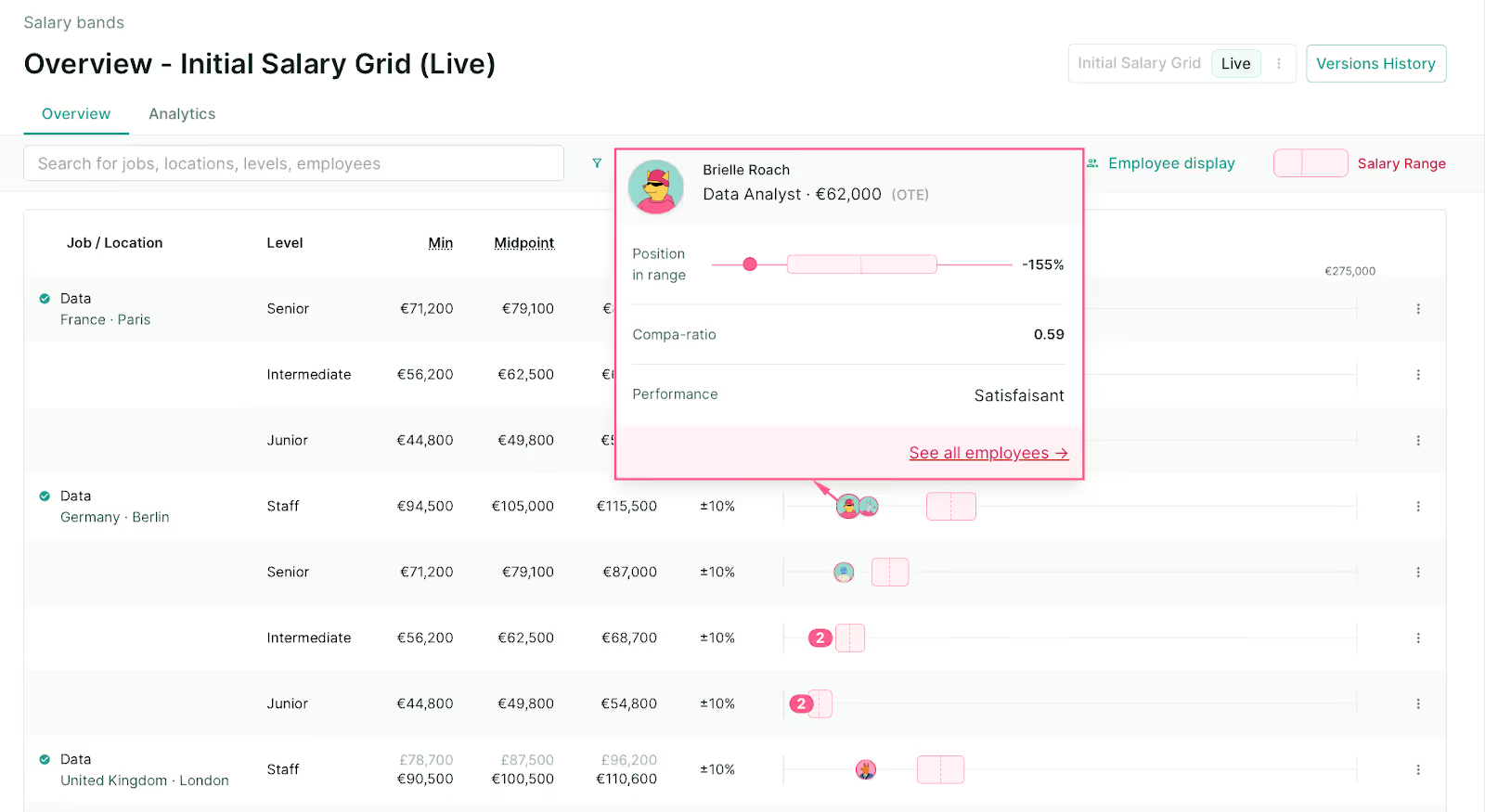Key points:
- Pay compression kills retention: When experienced employees discover they earn just €2,000-5,000 more than new hires, they start job hunting – it's a data problem disguised as a people problem.
- The 90% rule matters: Direct reports shouldn't exceed 90% of their manager's pay – when this boundary blurs, you've got compression.
- Real-time data beats annual surveys: Traditional benchmarking fails because markets move faster than yearly reports – you need monthly updates to stay competitive.
- Transparency requires timing: Revealing pay gaps before fixing them explodes retention problems – communicate strategically, not reactively.
- 2026 deadline approaches: EU Pay Transparency Directive forces disclosure anyway – companies acting now gain competitive advantage while others scramble.
- Figures solves the infrastructure problem: 3.5 million verified data points + 30 HRIS integrations = compression patterns spotted instantly, not after resignations.
Picture this: your five-year senior developer just discovered the junior hire they’re mentoring earns just €2,000 less.
Now they’re updating their LinkedIn profile during lunch breaks.
This scenario plays out daily across companies experiencing pay compression, when salary gaps between new and experienced employees shrink to almost nothing. It’s destroying morale, triggering resignations, and turning your best performers into flight risks.
But here’s the thing: pay compression isn’t inevitable. It’s a solvable data problem disguised as a people problem.
This guide reveals exactly how to identify, fix, and prevent pay compression before it decimates your retention rates.
What is pay compression? When new hires earn more than veterans
Pay compression is when salary differences between new and experienced employees become minimal. This happens when newly hired staff earn nearly as much as colleagues who’ve been with the company for years.
Remember our senior developer from earlier? Their situation perfectly illustrates pay compression. Five years of loyalty, expertise, and institutional knowledge – valued at just €2,000 more than someone they’re training.
Also known as salary compression or wage compression, this phenomenon creates a domino effect of frustration. When experienced employees discover these minimal pay gaps, they don't just feel undervalued – they feel foolish for staying.
Why does pay compression happen?
The biggest reason is that market rates have skyrocketed. Someone hired 10 years ago might have received steady 3% annual raises, but if market salaries jumped 40% during that time, their compensation hasn’t kept pace. Companies must offer competitive starting salaries to attract talent, even when it means new hires earn almost as much as their experienced colleagues.
Then, there are also these common triggers:
- Minimum wage increases: When the wage floor rises, it pushes up starting salaries across the board, but existing salaries don’t always adjust proportionally.
- Talent wars: That unicorn candidate with the perfect skills? They might command a premium that disrupts your entire pay structure.
- Ad hoc pay decisions: Without documented salary bands or consistent practices, each hiring decision becomes a potential compression point.
- Economic shifts: Inflation, skill shortages, or industry disruptions can rapidly change what constitutes “competitive” pay.
Here’s the kicker: when compression goes unchecked, it can spiral into wage inversion, where new employees actually out-earn their experienced teammates. Imagine training someone who makes more than you do. Not exactly a recipe for workplace harmony, is it?
The business impact: retention, morale, and productivity
When experienced employees discover they’re earning marginally more (or less!) than new hires, the psychological impact hits hard. They feel undervalued, questioning why their years of institutional knowledge and proven track record aren’t reflected in their pay.
The ripple effects are predictable and costly:
- Plummeting morale: “Why should I mentor new hires who earn nearly as much as me?”
- Increased turnover: Your best performers leave for companies that properly value experience.
- Productivity nosedive: Demotivated employees rarely bring their A-game.
- Knowledge drain: When veterans leave, they take years of expertise with them.
Now, with all those negative effects, you might be wondering: “Is pay compression illegal?”
Pay compression is legal unless it masks discrimination against protected classes, though it violates no UK or EU employment law. However, legal doesn’t mean wise. If compression disproportionately affects women, older workers, or minority groups, you could face discrimination claims that damage both your reputation and finances.
Besides the obvious, there’s also a hidden cost: replacing an experienced employee typically costs 1.5-2x their annual salary. When compression drives out multiple veterans, those recruitment and training expenses compound quickly, turning a compensation challenge into a full-blown crisis.
3 steps to correct pay compression
Discovering pay compression in your organisation is like finding cracks in the foundation – ignore them, and the whole structure could weaken over time. But unlike a full-scale renovation, fixing pay compression doesn’t mean starting from scratch; it’s about making smart adjustments to restore balance and stability.
Here’s your practical roadmap to restore fair compensation without chaos or mass resignations.
1. Identify pay compression in your organisation
You’re experiencing pay compression if colleagues with less experience earn within €5,000 of your salary or if new job postings for your role advertise 15%+ above your current pay.
Start with the 90% rule: direct reports shouldn’t exceed 90% of their manager’s pay. When this boundary blurs, you've got compression.
Red flags to spot:
- New hires negotiating salaries dangerously close to veteran employees.
- Difficulty promoting internally because the pay increase seems insignificant.
- High performers leaving for “lateral” moves that pay 20% more.
- Managers discovering their reports earn nearly as much (or more!).
The solution? Conduct thorough pay equity reviews that examine your entire compensation structure, not just individual cases. Here’s what that includes:
- Map out salary relationships across teams, departments, and experience levels.
- Look for patterns where tenure and expertise aren’t reflected in pay differences.
- Document everything – you’ll need this data to build your business case for corrections.
Pro tip: Anonymous salary surveys can reveal compression you didn’t know existed. Employees often know about pay disparities before HR does.
2. Keep track of and align with market rates
What looks like a morale crisis is often a data visibility problem.
How do you fix wage compression? It begins with an accurate diagnosis. Forget those outdated salary sites where anyone can post fictional figures. Real market intelligence requires verified, current data from actual payroll systems.
Here’s the reality check: traditional benchmarking fails because markets move faster than annual surveys. By the time that industry report lands on your desk, salaries have already shifted.
Here’s how to avoid that:
- Ditch the guesswork: Stop cobbling together estimates from Glassdoor and water cooler gossip. These self-reported figures create more confusion than clarity.
- Embrace real-time intelligence: Modern platforms like Figures Benchmark tap into 3.5 million verified European salary data points, updated monthly, not annually. This means catching market shifts as they happen, not discovering them through resignation letters.
- Build sustainable salary bands: The shift from individual fixes to systemic prevention happens through properly structured salary bands with regular market true-ups. Figures Salary Bands offers ranges synced with live market data, turning compensation planning from art into science.

💡 Remember: When adjusting salaries, consider the complete renumeration package. Sometimes, enhanced benefits, flexible working, or development opportunities can bridge gaps while you phase in salary corrections.
3. Communicate compensation changes to your team
Fixing pay compression without proper communication is like changing the office layout overnight – employees arrive to find everything’s different and their snacks have been moved, but nobody explained why, creating confusion and suspicion.
Overall, pay transparency builds trust, but it needs to be handled with care. When employees discover pay disparities through corridor whispers rather than official channels, trust evaporates faster than spilled coffee on a hot desk.
Here’s the paradox: pay transparency can actually worsen compression if poorly managed. Imagine revealing salary bands before fixing existing inequities – suddenly, everyone knows they’re underpaid, and your retention problem explodes.
Smart communication follows this sequence:
- Acknowledge the issue: “We've identified pay compression and we're fixing it.”
- Share the timeline: Be realistic about correction phases.
- Explain the process: Show how decisions are data-driven, not favouritism.
And from next year, this won’t be a choice: the EU Pay Transparency Directive arrives in 2026, requiring companies with 100+ employees to disclose salary ranges and report pay gaps. But here’s the thing – companies acting now gain a competitive advantage while others scramble for last-minute compliance.
“Controlled transparency during compression fixes prevents the chaos of forced disclosure later. Start conversations now, on your terms, rather than playing catch-up when regulations force your hand.” Agnès Chauvigny, VP People at Figures.
Transform your compensation strategy with Figures’ data-driven solutions
Pay compression is a morale issue, but most of all, it’s a retention crisis waiting to happen. Thankfully, what once required months of spreadsheet chaos now takes minutes with proper infrastructure.
Figures' integration with 30+ HRIS systems makes it the ideal solution for identifying pay compression across departments. Hidden patterns emerge instantly when your siloed data finally talks to each other.
The platform addresses compression’s core challenge – balancing internal equity with market competitiveness – through 3.5 million real-time data points (powered by Mercer). No more guessing whether new hire salaries disrupt team dynamics. Instead:
- Benchmark salaries against verified market data.
- Build salary bands that auto-adjust with market shifts.
- Identify pay gaps before they become retention risks.
- Access compliance-ready modules for EU Pay Transparency (2026).
The bottom line? Companies solving compression today become tomorrow’s employers of choice. While competitors scramble to explain unfair pay gaps, you'll confidently share transparent structures that prove fairness.
You can either stay reactive and watch talent leave, or become proactive with infrastructure that prevents problems before they start.
Ready to fix compression permanently? Book a demo and discover how Figures turns compensation chaos into strategic clarity.


.png)
.png)
.jpg)

